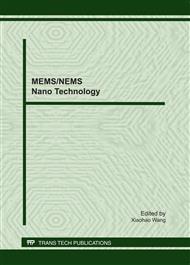[1]
M. Gad-el-Hak, The fluid mechanics of microdevices—the freeman scholar lecture, Journal of Fluids Engineering, 121(1999) 5-33.
DOI: 10.1115/1.2822013
Google Scholar
[2]
S. A. Schaaf, P. L. Chambre, Flow of rarefied gas, part H of Fundamentals of Gas Dynamics, Princeton Univ. Press, (1958).
DOI: 10.1515/9781400877539-010
Google Scholar
[3]
Burgdorfer, The influence of the molecular mean free path on the performance of hydrodynamic gas lubricated bearings, Journal of Basic Engineering, 81(1959) 94-100.
DOI: 10.1115/1.4008375
Google Scholar
[4]
Y. T. Hsia, G. A. Domoto, An experimental investigation of molecular rarefaction effects in gas lubricated bearings at ultra-low clearances, Journal of Lubrication Technology, 105(1983) 120-130.
DOI: 10.1115/1.3254526
Google Scholar
[5]
Y. Mitsuya, Modified Reynolds equation for ultra-thin film gas lubrication using 1. 5-order slip flow model and considering surface accommodation coefficient, Journal of Tribology, 115(1993) 289-294.
DOI: 10.1115/1.2921004
Google Scholar
[6]
S. Shen, G. Chen, R. M. Crone, et al, A kinetic-theory based first order slip boundary condition for gas flow, Physics of Fluids, 19(2007) 086101.
DOI: 10.1063/1.2754373
Google Scholar
[7]
L. Wu, A slip model for rarefied gas flows at arbitrary Knudsen number, Applied Physics Letters, 93(2008), 253103.
DOI: 10.1063/1.3052923
Google Scholar
[8]
E. S. Piekos, K. S. Breuer, Pseudospectral Orbit Simulation of Nonideal Gas-Lubricated Journal Bearings for Microfabricated Turbomachines, Journal of Tribology, 121(1999) 604–609.
DOI: 10.1115/1.2834110
Google Scholar
[9]
L. X. Liu, C. J. Teo, A. H. Epstein, et al, Hydrostatic gas journal bearings for micro-turbomachinery, Journal of Vibration and Acoustics, 127(2005) 157-164.
DOI: 10.1115/1.1897738
Google Scholar
[10]
C. J. Teo, Z. S. Spakovszky, S. A. Jacobson, Unsteady flow and dynamic behavior of ultrashort lomakin gas bearings, Journal of Tribology, 130(2008) 011001.
DOI: 10.1115/1.2805403
Google Scholar
[11]
Y. Lee, H. Kwak, C. Kim, et al, Numerical prediction of slip flow effect on gas-lubricated journal bearings for MEMS/MST-based micro-rotating machinery, Tribology international, 38(2005) 89-96.
DOI: 10.1016/j.triboint.2004.01.003
Google Scholar
[12]
H. Huang, G. Meng, S. Zhao, The effects of second-order slip flow on the steady performance of micro gas bearings, Chinese Journal of Theoretical and Applied Mechanics, 38(2006) 668-673. (in Chinese).
Google Scholar
[13]
J. Zhou, G. Meng, W. Zhang, 2007, Characteristics of micro gas journal bearings, Journal of Vibration and Shock, Vol. 26, No. 9, 2007 30-33. (in Chinese).
Google Scholar


